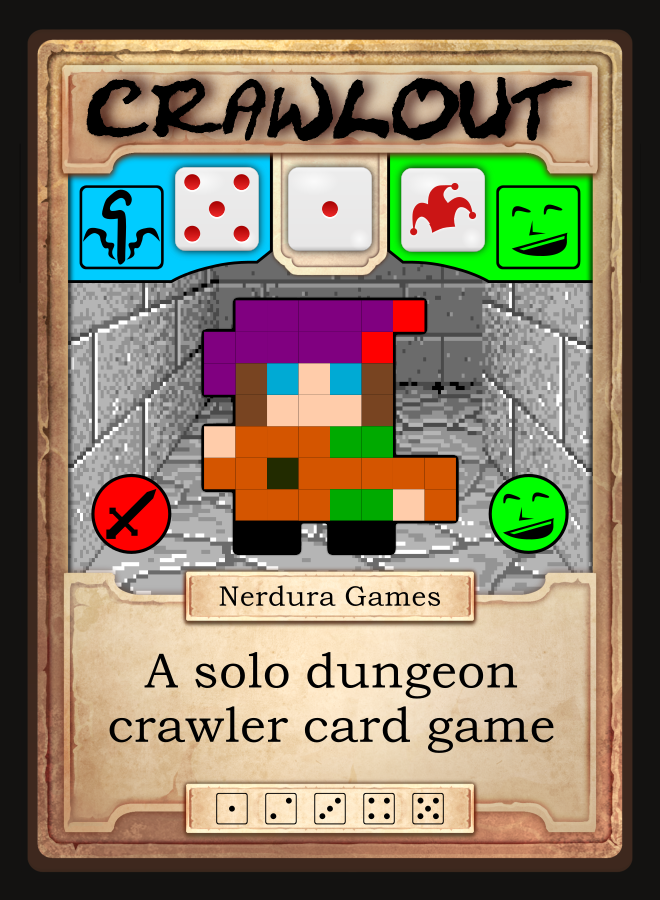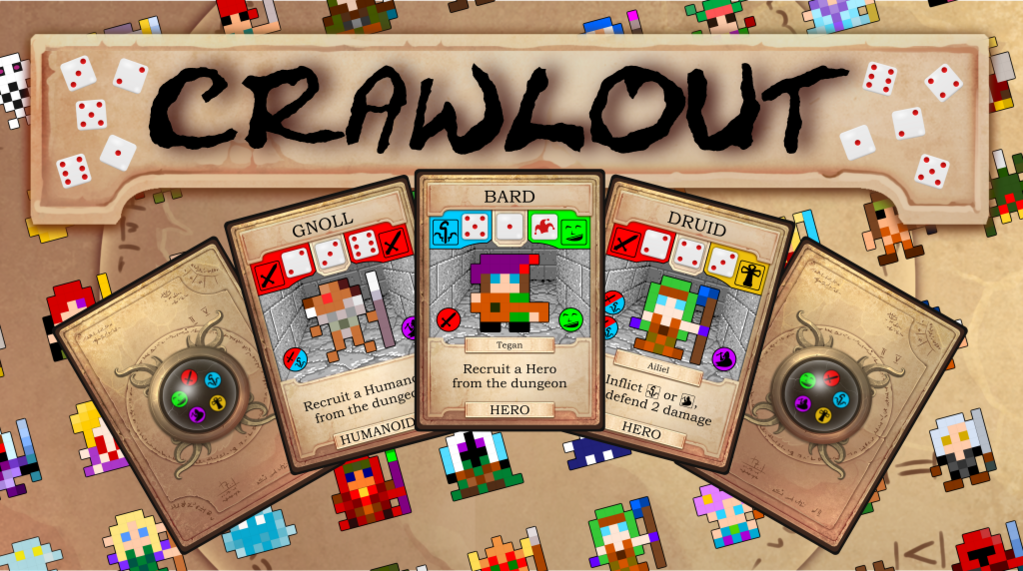
Click here to buy Crawlout on DriveThruRPG
Crawlout is a solo dungeon crawler card game, bringing some fresh meat to the dedicated dungeon crawlers out there. Kill monsters, recruit allies, gather treasure, and survive to tell the tale. The game will only be available as a print & play product.

Game mechanics are easy to learn, stress-free, and never (too much) punitive, suitable for both young and seasoned players. Every game will be different, cause you start your adventure with 3 random Heroes from a pool of 25. Moreover, many Heroes can recruit new allies, turning foes into party members. The Warlock will bring demons in the fray, while the Necromancer can command undeads to join, and so on. Enter the dungeon and aim for the perfect score!
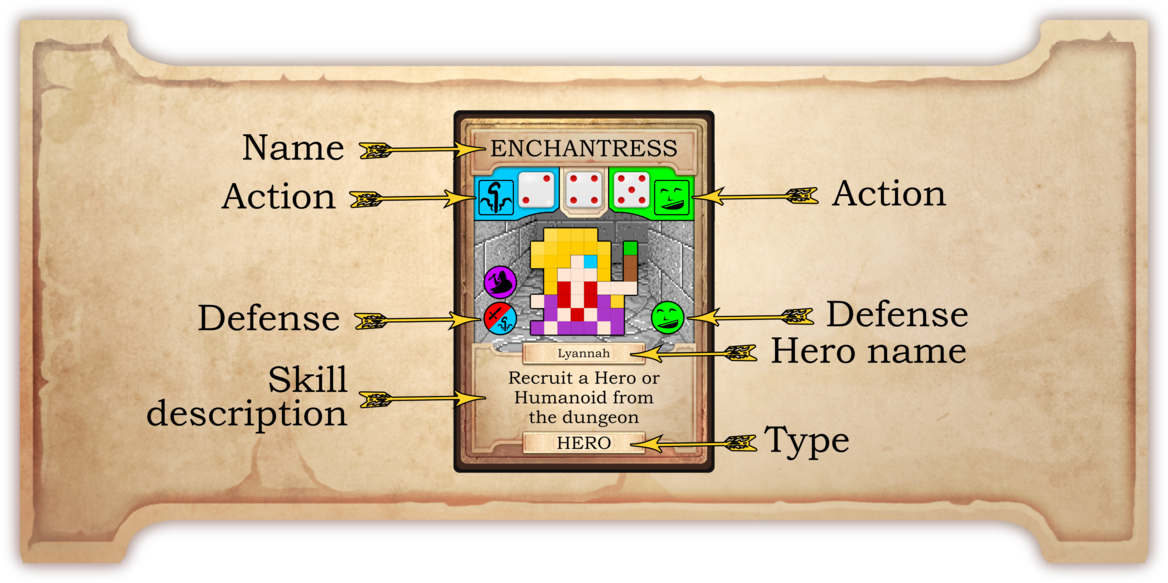
You play by rolling a small pool of six-sided dice, starting with 5d6. Once rolled, dice are placed on the number-matching dice icons of your party cards, activating an action (left and right icons) or the skill (central one), described in the text. The fueled actions will beat the dungeon cards defenses, shown as round icons.
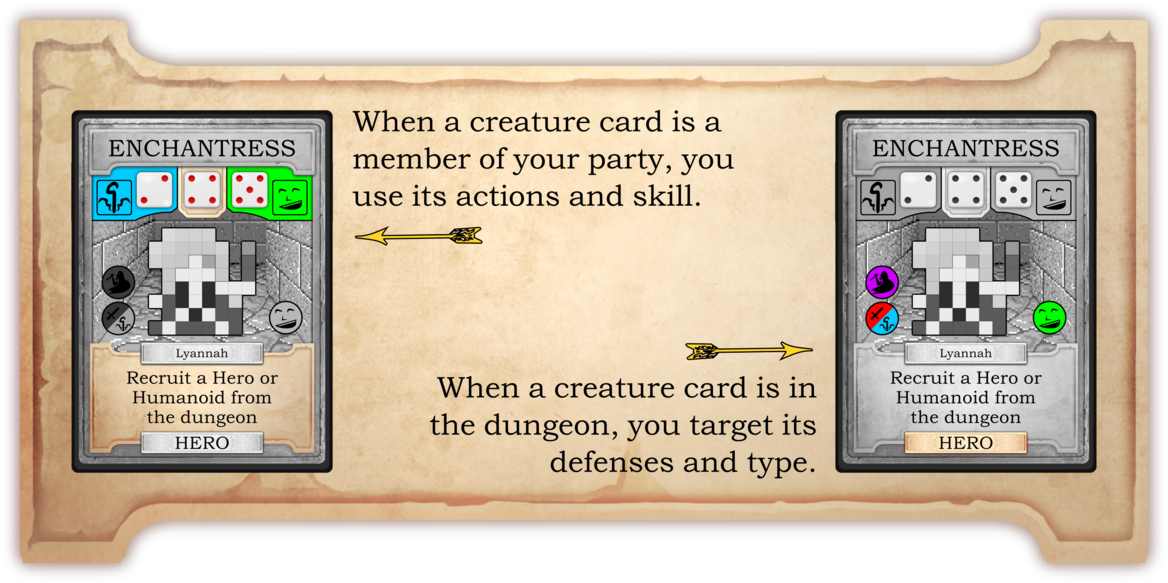
There are 5 actions and related defenses:
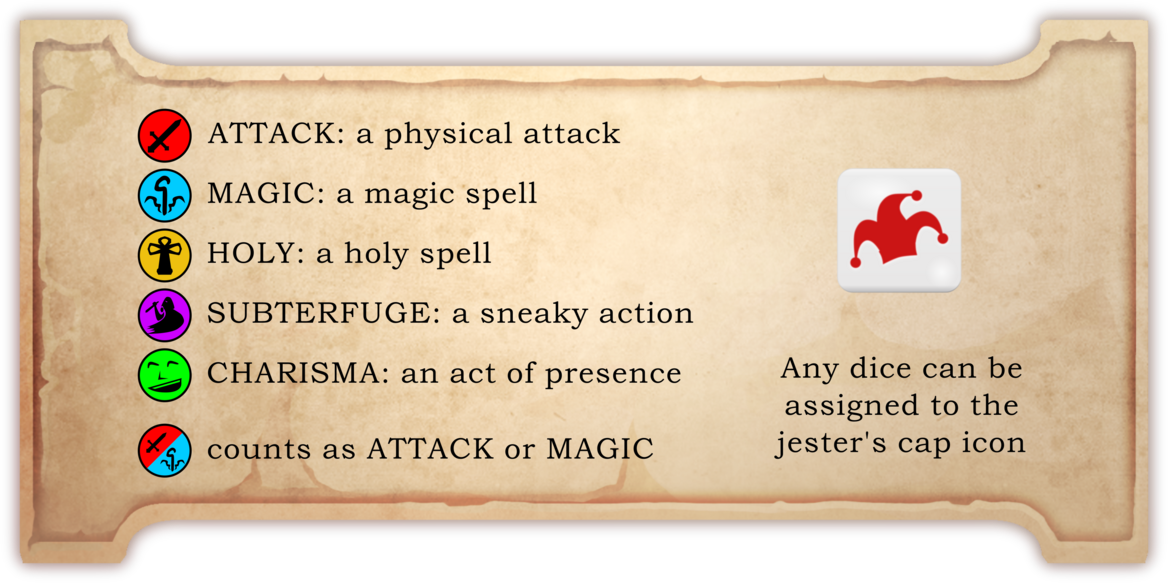

You won't meet just creatures; snag cards represent doors, traps and other unforeseen events, while item cards are single use effects that will give you a hand.
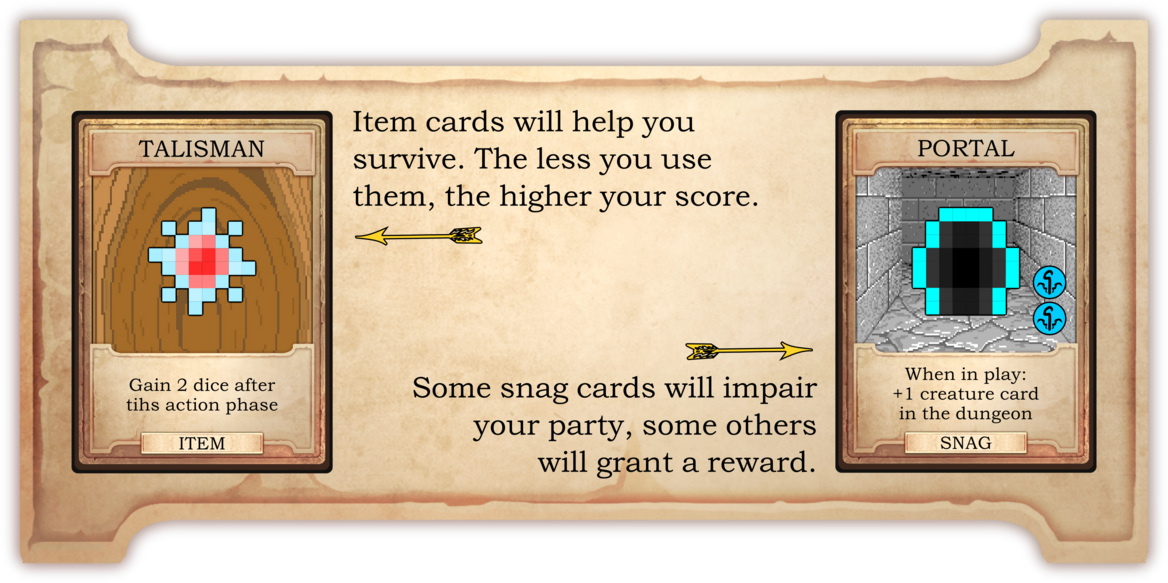
Let's take a look at the five phases.

Setup: you randomly pick 3 Hero type cards (your starting party), then you shuffle the rest of the cards and place the deck on the table.
The game cycles through 5 phases:
1 - Draw. You draw cards until you have 5 creature cards placed face up in the dungeon zone. Any drawn snag card does't count against the limit, and any drawn item card is kept: you can use it later.
2 - Roll. Discard any d6 past the 5th and roll your dice. Keep the results.
3 - Assign. You can put one d6 on each party card, matching the number of a die icon. You can assign any number to the jester's cap icon. Assigning a d6, you activate the matching action or skill. Left and right icons activate an action, while central icon activates a card's skill, described in its text. If you end up having some party cards with no assigned die, those party cards won't act in the action phase. If you won't assign some dice, each unassigned d6 will count as 1 defense point during damage phase. You aren't forced to assign any d6; you can choose to assign none.
4 - Action. Party cards act one at a time, in any order. Their activated actions must match and beat the defenses of dungeon cards. Sometimes, two or three activated actions/skills on multiple party cards are needed to beat a dungeon card. A card's defenses are shown as colored circles on the left and right sides of its portrait. To beat a card, the party must provide a color-matching amount of actions enough to beat the left side defenses or the right side ones. The half red half blue circles are beaten by a red or a blue action. Once beaten, a card goes face up in the cemetery (the discard pile). Once a party card uses its activated action or skill to beat a dungeon card, it can't use that action to beat another card. A party card can only target a single dungeon card. Any number of item cards can be used in this phase.
5 - Damage. For each unbeaten creature card left in the dungeon, the party suffers 1 damage. Some snag cards also deal damage in this phase if they are in the dungeon, as stated in their description. For every point of damage taken, you must discard one of your party cards. To negate damage, you can do the following things:
- each previously unassigned d6 negates 1 damage;
- an activated party card's skill negates damage: see skill description;
- an item card used in the previous action phase provides damage protection;
- burn a d6 to negate 1 damage. When you burn a die, you permanently reduce your dice pool (ex, from 5d6 to 4d6). Some items can raise back the dice pool. You can't burn the last die.
Victory and defeat. If you manage to beat all of the dungeon cards and the deck cards, you win. If at the end of damage phase all of your party cards are discarded, because they received damage or for any other effect, you lose. If you end up stalling and there still are cards in the dungeon, you lose.
If you win, count the total of your party cards and item cards that aren't in the cemetery: this is your score.
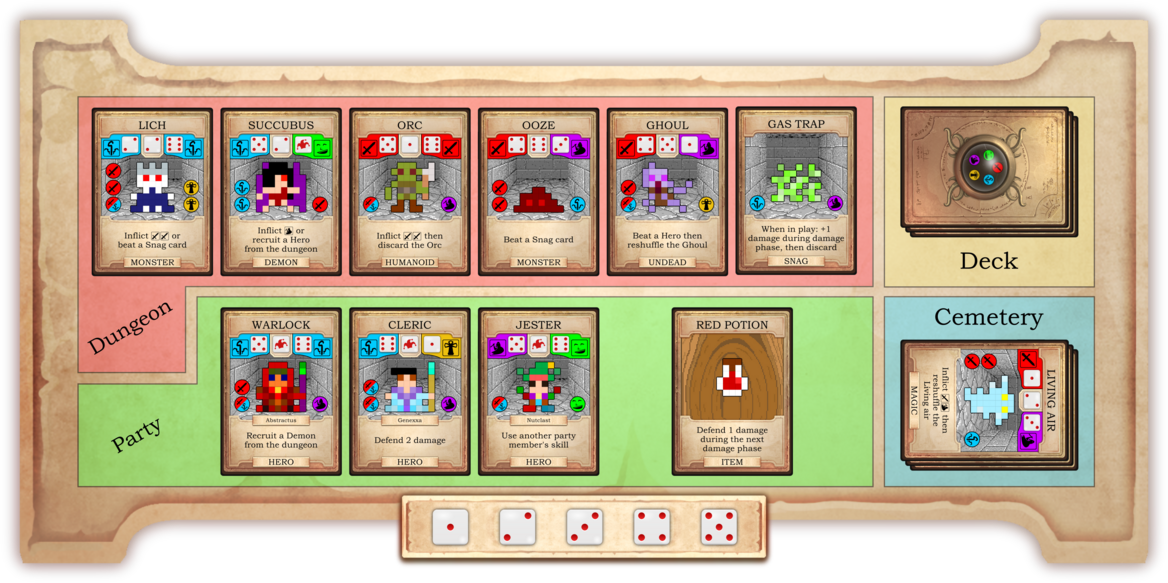
Common skills effects include:
Recruit: a creature card of a certain type becomes a party card. You can't have more than five party members: if you recruit the sixth member, you must discard one of the former members and keep the new one. You can't assign a dice to a newly recruited card: you must wait until the next assign phase.
Reroll: you roll again all of your unassigned dice. You must keep the new results, unless you can use another reroll. You can exceptionally assign any number of the newly rerolled dice even if you are playing the action phase.
Reshuffle: A card in play is reinserted in the deck, roughly halfway (no need to count the cards).
Burn a d6: as previously described, burning a die during damage phase negates 1 damage, reducing your dice pool by one. When a card skill requires to burn a die, the burnt d6 will be the one that activated that skill.
Gain a d6: when you gain a die, you will gain it right after the end of the current action phase.
And now, some frequently asked questions.

Q - What do I need to play?
A - The printed deck of cards and 5 or more d6.
Q - What about game duration and replayability?
A - A game takes more or less half an hour, depending on your playstyle and experience with the game. You can decide to play with half deck for a quick run. The game is highly replayable, cause every run will be different, like in many roguelike games.
Q - How many cards are in the deck? What do I need to play?
A - You need your six-sided dice. You'll usually roll five, but bring some extra d6 for the temporary boosts. The deck counts 82 cards.
Q - What about card design?
A - I tried to transduce the peculiarities of each creature within the rules boundaries. So, if you ponder a card's potential, you'll see it matches its traditional pen and paper counterpart. Also, I wanted to draw every central element in a 8x8 pixel grid. Why do I so love pixel art? Must be my building bricks childhood (which still has to come to an end), and the old memories of C64, when as a kid I encoded lots of sprites using the DATA command lines and powers of 2.
Q - Have you any plans for Crawlout's future?
A - Depending on Crawlout success, I could release more cards in themed micro expansions, inspired to famous adventure modules. I'd also like to write Heroes backstories. However, this largely depends on the time I'll be able to dedicate to the game, so it's tied to my earnings as a game designer. The more you'll love it, the more Crawlout will love you.
Q - How come this amazing game is so cheap?! Shut up and take my money!!
A - Everyone should enjoy Crawlout, so I adopted the "buy me a coffee" policy. I hope that the affordable price will encourage everyone to try Crawlout.

